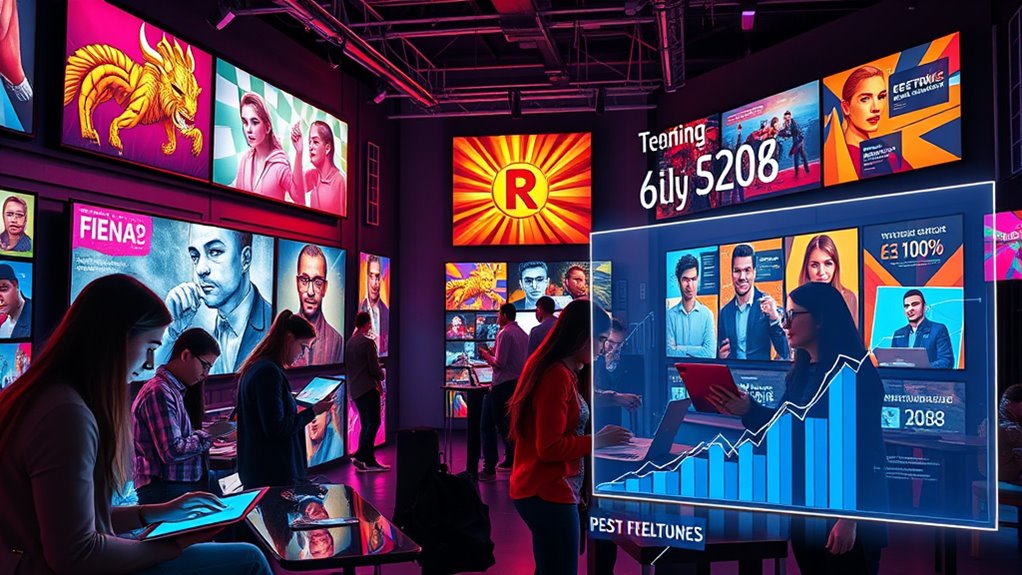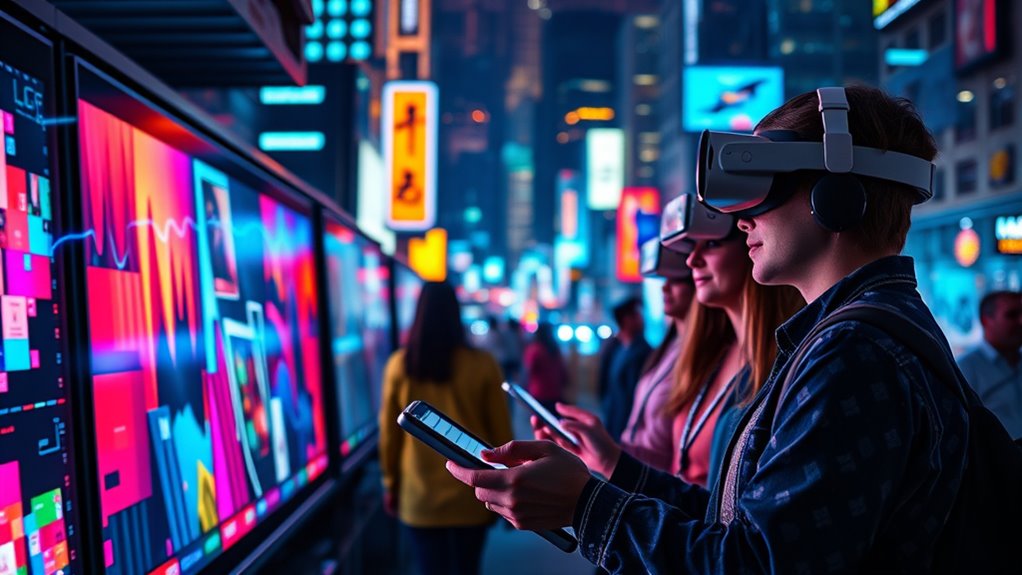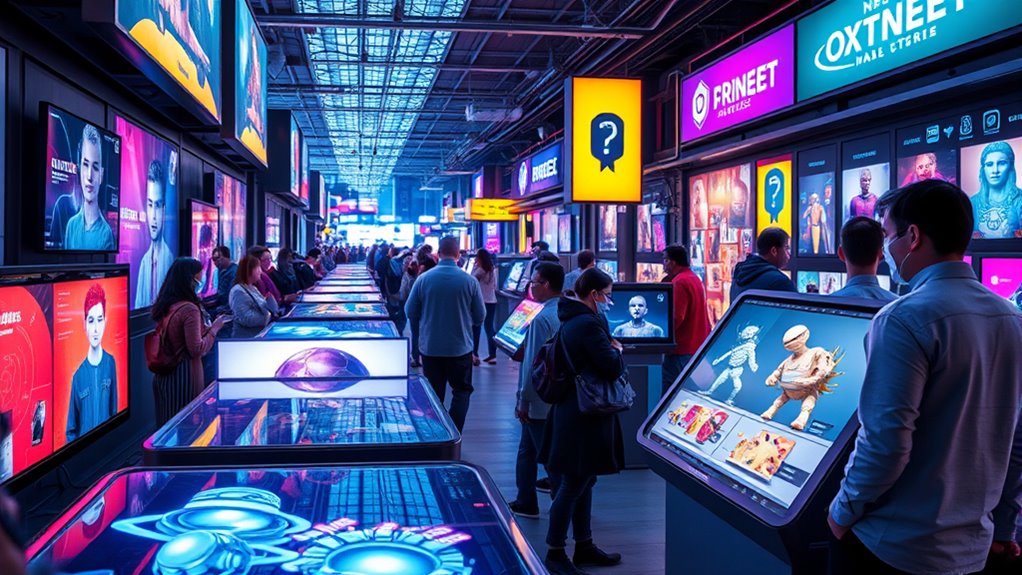The digital art market’s rapid growth opens exciting opportunities for you to showcase, sell, and expand your reach globally through online platforms and virtual galleries. You can leverage blockchain and NFTs to protect your work and earn more through royalties. Building a strong digital presence and personal brand helps attract collectors and collaborators. If you explore the evolving tools and trends, you’ll discover how to maximize your creative potential in this expanding industry.
Key Takeaways
- Digital platforms and virtual exhibitions broaden global reach, increasing exposure and sales opportunities for creators.
- Blockchain and NFTs provide new monetization channels, ensuring authenticity, digital scarcity, and fair compensation.
- Online marketplaces and digital galleries enable direct sales, reducing reliance on physical venues and expanding market access.
- Building a strong personal brand through social media and collaborations enhances visibility and long-term growth.
- Emerging technologies like AR and AI offer innovative ways to engage audiences and push creative boundaries.
The Evolution of Digital Art Platforms

Digital art platforms have transformed remarkably over the past decade, making it easier for artists to showcase and sell their work globally. You can now participate in virtual exhibitions that reach audiences worldwide without leaving your studio. These platforms foster collaboration, enabling you to join or create collaborative projects that blend different styles and ideas. Virtual exhibitions provide a dynamic space to display your art, attract potential buyers, and gain exposure. Collaborative projects allow you to work with other artists across borders, expanding your creative horizons and building your network. As a result, digital platforms have democratized art distribution, giving you more control over your career. This evolution empowers you to innovate, connect, and grow in ways that weren’t possible before. Additionally, the rise of digital marketplaces has provided new avenues for monetizing your art and reaching niche audiences.
Leveraging Blockchain and NFTs for Monetization

Blockchain technology transforms how you authenticate and sell digital art, giving you more control and security. NFTs create new market dynamics by enabling artists to monetize unique pieces directly from collectors. By leveraging these tools, you can maximize your earning potential and build a sustainable digital art career. Additionally, understanding ventilation considerations can help you create a comfortable environment for showcasing your work and engaging with your audience.
Blockchain’s Role in Art
While traditional art markets have long struggled with issues of provenance and authenticity, blockchain technology offers a powerful solution by providing an unchangeable record of ownership. You can use blockchain for digital authentication, ensuring your art’s legitimacy is verifiable at any time. Smart contracts automate transactions, reducing the need for intermediaries and increasing transparency. This technology empowers you to protect your rights and monetize your work more effectively. Additionally, digital certificates of authenticity can be issued using blockchain to further enhance buyer confidence.
NFT Market Dynamics
NFTs (non-fungible tokens) have revolutionized how artists and collectors monetize digital assets by combining blockchain’s secure record-keeping with unique digital identifiers. This creates digital scarcity, making each piece one-of-a-kind and highly valuable. As a result, you can sell digital artworks with proof of ownership and authenticity, boosting their market value. Virtual galleries now serve as accessible platforms where NFTs can be showcased and traded globally, expanding your reach. The dynamic nature of the NFT market means prices can fluctuate based on demand, rarity, and cultural relevance. By leveraging blockchain technology and virtual galleries, you gain new opportunities to monetize your work beyond traditional channels, tapping into a global audience enthusiastic to invest in exclusive digital assets. Additionally, understanding the fundamentals of digital asset security helps protect your creations and build trust with collectors.
Benefits for Creators
By leveraging blockchain technology and NFTs, you open new ways to monetize your digital art beyond traditional channels. These tools enable you to participate in collaborative projects, expanding your network and creating unique, limited editions that increase your work’s value. You gain greater control over your intellectual property, ensuring fair compensation through smart contracts that automate royalties on secondary sales. NFTs also boost audience engagement by allowing fans to own and trade your art, fostering a deeper connection with your community. This direct relationship eliminates middlemen, maximizing your earnings and visibility. Additionally, understanding the significance of color accuracy in digital displays can help you present your artwork in the most compelling way possible. Overall, blockchain and NFTs empower you to turn your creativity into sustainable income streams while building an engaged, supportive audience enthusiastic to champion your work.
Expanding Reach Through Online Galleries and Marketplaces

Online galleries and marketplaces give you access to a global audience, breaking down geographic barriers. This opens up more sales opportunities and helps you reach collectors worldwide. With diverse platform options, you can choose the best fit to showcase your art and grow your presence. Additionally, leveraging advanced fraud detection techniques can help protect your transactions and build trust with buyers.
Global Audience Access
Online galleries and marketplaces have markedly expanded the reach of digital art, allowing audiences worldwide to discover and purchase works with ease. Virtual exhibitions enable you to showcase your art beyond physical boundaries, attracting viewers from different countries without geographic limits. These online platforms make it simple for potential collectors to explore your portfolio at any time. Additionally, social media outreach amplifies your visibility, connecting you directly with interested audiences and art enthusiasts globally. By leveraging these tools, you can build a diverse, international following that appreciates your style and supports your growth. The combination of virtual exhibitions and strategic social media engagement broadens your access to a vast, engaged audience, opening doors to new opportunities and increasing your influence in the digital art world. Incorporating digital art market growth insights can help you tailor your online presence for maximum impact.
Increased Sales Opportunities
Expanding your presence through digital galleries and marketplaces substantially boosts your sales opportunities. By participating in collaborative projects, you can tap into new audiences and build your reputation within the digital art community. These platforms often feature curated collections, increasing your artwork’s visibility to potential buyers worldwide. Additionally, social media promotion plays a vital role; sharing your work across channels drives traffic to your online galleries, attracting more interested collectors. Many marketplaces also offer targeted advertising options, helping you reach specific demographics. As a result, you gain more chances to sell your art directly, without relying solely on physical exhibitions. Incorporating artistic collaborations with other creators can further enhance your exposure and credibility. Overall, leveraging online galleries, marketplaces, collaborative projects, and social media expands your reach and enhances your ability to generate consistent sales in the digital art market.
Diverse Platform Options
Have you considered how different digital platforms can substantially boost your art sales? Online galleries and marketplaces open doors to a broader audience, increasing your visibility. Many platforms support virtual collaborations, allowing you to work directly with collectors or other artists worldwide. These collaborations can lead to unique projects that stand out. Additionally, interactive exhibits give potential buyers immersive experiences, making your art more engaging and memorable. By leveraging diverse platform options, you can showcase your work in innovative ways, reaching audiences beyond traditional galleries. Whether through virtual collaborations, interactive exhibits, or other digital tools, these resources help you build a stronger presence in the digital art market. Expanding your reach has never been easier, opening new opportunities to grow your creative career.
Building a Personal Brand in the Digital Space

Ever wondered how to stand out in the crowded digital art world? Building a personal brand is essential. First, focus on creating a consistent online presence across social media platforms. Share your process, showcase your best work, and engage authentically with followers. Second, leverage influencer collaborations to expand your reach; partnering with other creators introduces your art to new audiences. Third, develop a unique voice and style that reflect your personality—this helps others recognize and remember you. Remember, authenticity matters. By actively managing your digital footprint and collaborating strategically, you’ll establish a recognizable brand that attracts opportunities and fans alike. Incorporating colorful and distinctive artwork can also help make your portfolio stand out among others. Building your personal brand isn’t overnight, but these steps set a solid foundation for long-term growth in the digital art market.
Navigating Legal and Copyright Considerations

As you build your personal brand in the digital art space, understanding legal and copyright considerations becomes increasingly important. You need to be aware of fair use, which allows limited use of copyrighted material without permission, but only under specific circumstances. Misusing copyrighted works can lead to copyright infringement claims, risking your reputation and potential legal action. Always credit original creators and avoid copying entire works. When in doubt, seek permission or consult legal guidance to ensure you’re compliant. Protecting yourself from copyright infringement not only safeguards your work but also respects the rights of other artists. Staying informed about copyright laws helps you navigate this landscape confidently, ensuring your creative efforts remain lawful and your reputation remains intact. Additionally, being aware of content licensing and the importance of proper attribution can help you avoid legal pitfalls and foster respectful collaborations within the digital art community.
Strategies for Emerging Digital Artists

Breaking into the digital art scene requires strategic planning and consistent effort. To stand out, focus on building your brand through social media marketing. Share your process, engage with followers, and showcase your best work regularly. This boosts visibility and attracts potential buyers or collaborators. Additionally, participating in collaborative projects can expand your network and introduce your art to new audiences. Look for opportunities to join artist collectives or online challenges that align with your style. Incorporating content from the digital art market growth into your strategy can help you better understand industry trends and consumer preferences. Here are some effective strategies: 1. Develop a consistent posting schedule on social media platforms. 2. Engage with your community through comments and collaborations. 3. Seek out collaborative projects to diversify your portfolio and grow your presence. These approaches help you establish a solid foothold in the digital art market.
Future Trends Shaping the Digital Art Industry

The digital art industry is poised for dynamic changes driven by technological advancements and shifting consumer preferences. Augmented reality (AR) will become more integrated, allowing you to create immersive experiences that blend the physical and digital worlds. This technology enhances viewer engagement and opens new avenues for interactive art. Additionally, virtual exhibitions are gaining popularity, enabling you to showcase your work globally without physical constraints. These online platforms provide accessible, cost-effective ways to reach diverse audiences and foster community connections. As these trends evolve, expect more innovative tools that empower you to experiment and push creative boundaries. Staying ahead involves embracing AR and virtual exhibitions, which will shape how you present, sell, and connect with your audience in the future of digital art. Incorporating AI-driven personalization can further customize viewer experiences and increase engagement with your artwork.
Frequently Asked Questions
How Can Digital Artists Protect Their Work From Unauthorized Use?
You can protect your digital art by using watermarking techniques to deter unauthorized use and make your ownership clear. Also, actively enforce your copyright by monitoring platforms for misuse and filing takedown notices or copyright enforcement actions when needed. Staying informed about your rights and consistently applying these protections helps safeguard your work, ensuring you retain control and can take action if someone uses your art without permission.
What Are the Best Practices for Pricing Digital Art Pieces?
Ever wonder how to price your digital art effectively? Start with solid pricing strategies by researching similar works and considering your skill level. Do you understand your art’s true value? Assess your effort, uniqueness, and market demand to set fair prices. Remember, pricing isn’t just about covering costs but reflecting your art’s worth. By balancing these factors, you ensure your work is appreciated and properly valued.
How Does Audience Engagement Impact Digital Art Sales?
You see that viewer interaction boosts digital art sales by fostering stronger connections with your audience. When you actively engage with viewers through comments, live sessions, or social media, you build audience loyalty. This loyalty encourages repeat purchases and word-of-mouth referrals. The more you involve your audience, the more they feel invested in your work, increasing the likelihood they’ll support and buy your digital art regularly.
Which Social Media Platforms Are Most Effective for Promoting Digital Art?
Instagram and TikTok are your best bets for promoting digital art because their algorithms favor visual content and boost content virality. You should regularly post high-quality images and videos, engage with your followers, and use trending hashtags to increase visibility. These platforms reward consistent, engaging content, helping your artwork reach a wider audience and drive sales. Focus on storytelling and behind-the-scenes content to deepen audience connection.
How Can Artists Collaborate Across Digital Platforms Effectively?
Imagine your digital brushstrokes blending seamlessly across screens, like a painter’s hand guiding color from one canvas to another. To collaborate effectively, embrace virtual collaboration tools and focus on cross-platform networking. Share files, give real-time feedback, and maintain open communication. By leveraging these strategies, you create a vibrant digital studio where ideas flow freely, turning individual talents into a compelling collective masterpiece that reaches wider audiences.
Conclusion
As the digital art landscape continues to evolve, you have unprecedented opportunities to showcase your talent and monetize your work. By embracing new platforms, blockchain technology, and building your personal brand, you can carve out your space in this growing industry. But are you ready to navigate the challenges and seize the potential that digital art offers? The future belongs to those who innovate—are you prepared to lead the way?









